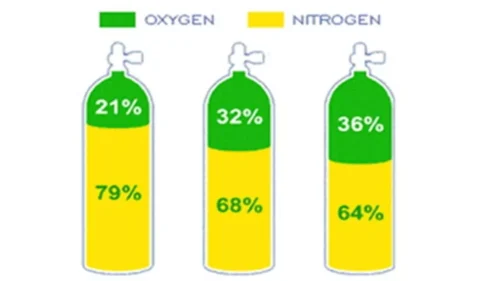Diving with Nitrox (Enriched Air): Dive Longer, Dive Safer? Decoding the Real Benefits
As you progress along your [scuba skills development pathway], you’ll hear a lot about “Nitrox” or “Enriched Air.” It’s the most popular PADI specialty course, yet many myths still surround it. Is Nitrox only for technical divers? Is it really “safer”?
This article will decode everything about Nitrox, a fantastic tool to help you maximize your time underwater.

What is Nitrox?
It’s very simple:
- Regular air that we breathe contains about 21% Oxygen and 79% Nitrogen.
- Nitrox (or EANx) is any gas mixture with an oxygen level higher than 21%.
In recreational diving, the two most common blends are EANx32 (32% Oxygen) and EANx36 (36% Oxygen).

The Biggest Benefit: Extended No Decompression Limit
This is the primary reason Nitrox is so popular. Our bodies absorb nitrogen while diving, and it’s this accumulated nitrogen that limits our bottom time. By breathing a gas mixture with less nitrogen (and more oxygen), your body absorbs nitrogen at a slower rate.
A practical example:
- At a depth of 25 meters (82 feet), your maximum no-stop time on regular air is 29 minutes.
- At that same depth, with 32% Nitrox, your time can extend to 40 minutes!
This benefit is especially noticeable on dives between 18-30 meters and when you’re making multiple dives a day—perfect for a dive holiday in Con Dao.
Is Diving with Nitrox “Safer”?
This is an important point to clarify. In theory, because you absorb less nitrogen, your risk of decompression sickness (DCS) is lower. Therefore, a smart way to use Nitrox is to dive your computer’s limits for air, but enjoy the added safety margin that Nitrox provides.
However, Nitrox is not a license to be reckless. Safety always comes from following your dive plan and proper procedures.
Risks and Requirements to Know
- Oxygen Toxicity: The main risk with Nitrox is breathing oxygen at too high a partial pressure. To avoid this, every Nitrox blend has a Maximum Operating Depth (MOD) that is shallower than air. You must never dive deeper than this limit.
- Requirements: You must be a certified Nitrox Diver. In the course, you’ll learn how to analyze the oxygen content in your cylinder and plan your dive according to the MOD.
Conclusion: Nitrox is not a gas for diving deep, but it is a fantastic tool for any diver who wants to safely maximize their exploration time at common depths. It’s a smart investment for anyone serious about scuba diving.
Ready to get more out of every dive? Enroll in the PADI Enriched Air (Nitrox) specialty course with Amadive today!
>>>Read More: PADI Advance Open Water Course
